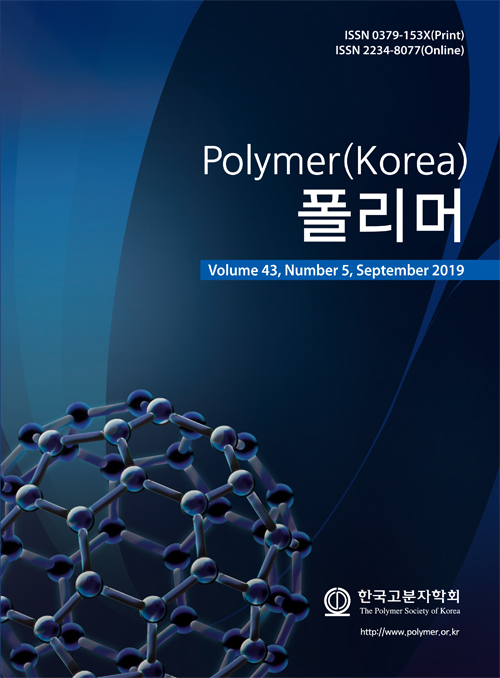- Preparation and Characterization of Absorbent Materials on Glass-Web Fibers for Removal of Mercury Ion
In-Soo Kang, Tae Jin Lee, Myung Jo Seo*, Sang Yeon Hwang**, No-Kuk Park†
 , and Seung Woo Lee†
, and Seung Woo Lee† 
School of Chemical Engineering, Yeungnam University, 280 Daehak-ro, Gyeongsan, Gyeongbuk 38541, Korea
*Micro-one Inc., 368 Yeongok-road, Ibjang-myeon, Seobuk-gu, Cheonan-si, Chungnam 31026, Korea
**Institute for Advanced Engineering (IAE), 175-28, Goan-ro 51beon-gil, Baegam-myeon, Cheoin-gu, Yongin, Gyeonggi-do 17180, Korea- 유리 망사 섬유를 지지체로 하는 수은 제거용 흡착체의 제조와 특성 평가에 대한 연구
영남대학교 화학공학부, *㈜마이크로원, **고등기술연구원
Absorbent materials for mercury removal were prepared using (3-aminopropyl)trimethoxysilane (APTMS) and trimethoxy(octyl)silane (TMOS) on the surface of glass web fiber. Surfaces of the absobent materials were characterized by attenuated total reflectance Fourier transform infrared (ATR-FTIR) and X-ray photoelectron spectroscopy (XPS). The elements of the modified surface in the absorbent materials were well accordance with those of APTMS or TMOS. Adsorption of mercury ion from mercury-contaminated water using the prepared absobent materials was studied. Quantitative measurement of mercury ion was carried out on inductively coupled plasma-optical emission spectroscopy (ICP-OES). The ability of mercury ion removal from mercury-contaminated water is in the sequence of APTMS-modified glass web > TMOS-modified glass web > pristine glass web. This sequence has relationship with chemical structure of APTMS and TMOS which were used for modification of glass web.
수은 이온의 제거를 위한 흡수체를 glass web을 지지체로 하고 그 표면을 (3-aminopropyl)trimethoxysilane (APTMS)와 trimethoxy(octyl)silane(TMOS)로 처리하여 제조하였다. 제조된 흡수체의 표면은 희석 총 반사율 적외선 분광법과 X-선 광전자 분광법을 이용하여 표면 처리 전의 glass web과 비교 분석하였다. APTMS와 TMOS는 지지체의 표면에 반응을 통하여 고정화되어짐을 확인하였다. 수은 이온의 제거 능력을 비교하기 위하여 glass web과 APTMS와 TMOS를 표면에 가지는 glass web을 유도 결합 플라즈마 방출 분광기 분석을 통하여 실험하였으며, 실험 결과 APTMS 표면 처리 glass web > TMOS 표면 처리 glass web > glass web의 순서로 중금속 수은 이온을 제거할 수 있음을 확인하였다. 이러한 순서는 glass web의 표면 처리에 이용된 APTMS와 TMOS의 화학 구조와 연관성을 가진다.
Keywords: absorbent materials, mercury ion, Fourier transform infrared spectroscopy, X-ray photoelectron spectroscopy, inductively coupled plasma-optical emission spectroscopy
- Polymer(Korea) 폴리머
- Frequency : Bimonthly(odd)
ISSN 0379-153X(Print)
ISSN 2234-8077(Online)
Abbr. Polym. Korea - 2023 Impact Factor : 0.4
- Indexed in SCIE
 This Article
This Article
-
2019; 43(5): 793-797
Published online Sep 25, 2019
- 10.7317/pk.2019.43.5.793
- Received on Jul 1, 2019
- Revised on Jul 30, 2019
- Accepted on Aug 5, 2019
 Correspondence to
Correspondence to
- No-Kuk Park, and Seung Woo Lee
-
School of Chemical Engineering, Yeungnam University, 280 Daehak-ro, Gyeongsan, Gyeongbuk 38541, Korea
- E-mail: nokukpark@gmail.com, leesw1212@ynu.ac.kr








 Copyright(c) The Polymer Society of Korea. All right reserved.
Copyright(c) The Polymer Society of Korea. All right reserved.